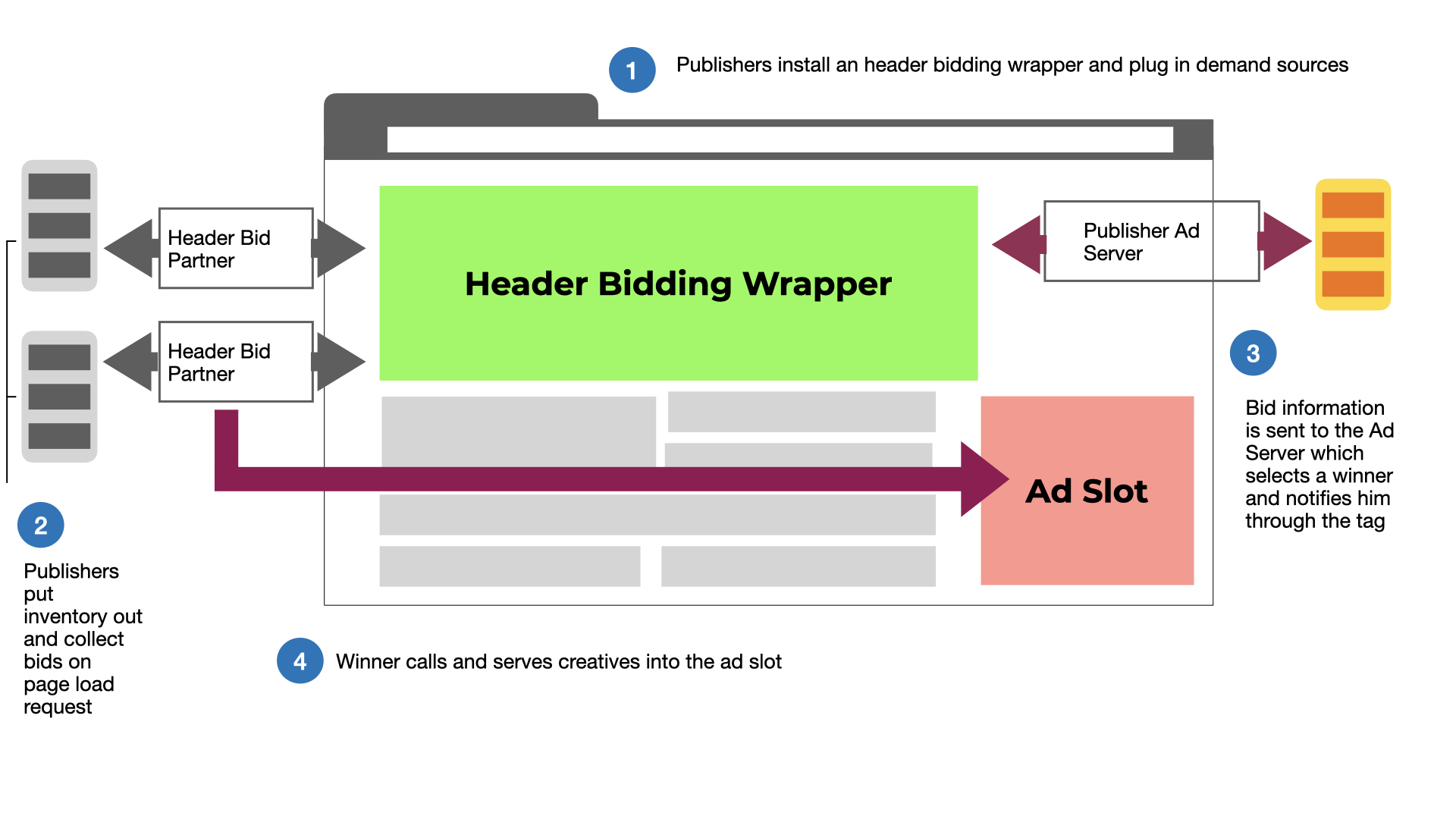What header-bidding is and how it works
Header-bidding, often defined as parallel bidding, works as a unified auction where publishers receive bids from a multitude of advertisers, and it aims at finding the highest paying ad among all the demand sources in real-time. Header-bidding gives publishers the opportunity to increase their profits while ensuring all advertisers have equal bidding opportunities and the right to access to quality inventory. In the waterfall model, publishers offer their ad slot to the highest bidder in a cascading fashion, which means that even if someone in the lower stage of the waterfall is willing to pay more than someone in the higher stage, they will never get the chance to compete for that slot if the bid is accepted higher up and the inventory is sold in the first rounds of the auction. Using header-bidding, on the other hand, everybody has the same opportunity and bids simultaneously.
 How does header-bidding work?
How does header-bidding work?
Header-bidding relies on a piece of javascript code that is embedded in the header of the publishers’ page in order to allow buyers to bid on ad spots. The functionality is quite easy:
- The user clicks through to a website
- The Publisher’s header tag sends a request to various ad networks
- Each ad network places its bids
- The winning bid is identified and passed to the Publisher’s ad server
- The Publisher’s ad server connects the user to the winning advertiser’s server
- The winning ad creative is showed to the user.
Implementing header-bidding can be a complicated process which requires to develop a lot of coding line and affect page load speed and, consequently, publishers’ revenue. In fact, if the page load is too slow, visitors will abandon it immediately without seeing any ads, which means no revenue for the publisher.
Two different technologies have been implemented to solve slow page loads: the header-bidding wrappers and the server-side header bidding.
The header-bidding wrapper is a code container ensuring all the bid requests are triggered at the same time and end in a timely manner. The wrapper is mostly used by publishers who work with several header-bidding solutions and it is used to organize multiple buyers as well as to set the rules for the auction.
The server-side header bidding technology tries to solve the latency issues associated with the client-side header bidding. Client-side header-bidding relies on a piece of Javascript code added to a publisher’s website in between the tags. The browser handles requests from individual networks, but if there are a lot of networks accessing the header wrapper, then a lot of Javascript processes are triggered and the load time of the page is slowed down.
Server-side header-bidding is similar to the client-side one, but the requests are handled by a central and external server rather than by the user’s browser. It still requires some code on the publisher’s web site but at the same time saves them from a lot of problems, as the page latency since all the work is transferred from the browser to the ad server.
Advantages of header bidding
Header-bidding has a lot of pro for both publishers and advertisers.
For publishers:
- Increasing competition and fill rates: offering impressions to a larger number of bidders increase competition and ensure higher CPMs and increasing revenues for publishers.
- No additional server adjustment: once publishers add the code into their website, no further adjustments are required unless new partners are added to the list.
- No demand management: partners claim the value of the impression in advance. This means publishers do not need to prioritize demand partners anymore.
- Minimal ad latency: header-bidding reduces the time for rendering the ad, improving user experience.
- Maximized yield: in the waterfall model, publishers offer their ad slot to the highest bidder in a cascading fashion and the value of each impression reduces over time. With the header-bidding model, on the other hand, each buyer bids at the same, and the value of every inventory is maximized.
- Transparency: since inventory is sold on a per-impression basis, publishers can track the ad transaction data for each impression. Furthermore, in the client-side header-bidding publishers and buyers can trade with each other through users’ browsers and without any intermediaries.
For advertisers:
- Higher quality placements: by bidding simultaneously, buyers have the opportunity to access to high-quality placements that were previously reserved for direct deals.
- Better viewability: in the waterfall model, some of the inventory is reserved in order to be sold in private marketplaces or direct deals. In the header-bidding, all the inventory is brought to the table and buyers have a complete view of the available inventory.
- Accurate ad targeting and reach: since advertisers have a better view of the ad inventory and demographics of the website visitors, they can use this data to improve their targeting strategy while getting the opportunity to reach niche audiences and global markets.
In-app header bidding
In-app header-bidding refers to the programmatic selling technique of running actions for mobile in-app ad impressions among multiple demand partners at the same time. Apps do not have headers where the code can be inserted, but in-app header-bidding works the same way as web header-bidding does. For apps, the principles of header-bidding can be applied by performing ‘parallel’ bidding via the mediation layer: the request is sent to multiple demand partners at the same time, and the highest bid is selected before calling the ad server.
Our header bidding solution: how to help publishers earn more
We provide publishers with an easy and independent platform developed to maximize revenues through an advanced header bidding solution. Our Instal for Monetization solution allows collecting data from the auction of every impression to predict and set optimal floor price rules across several ad exchanges.


